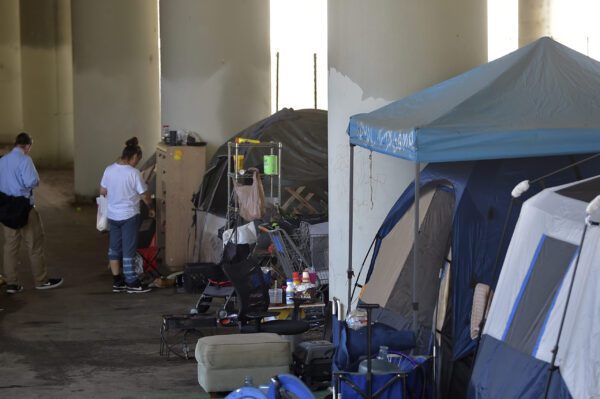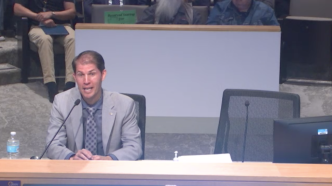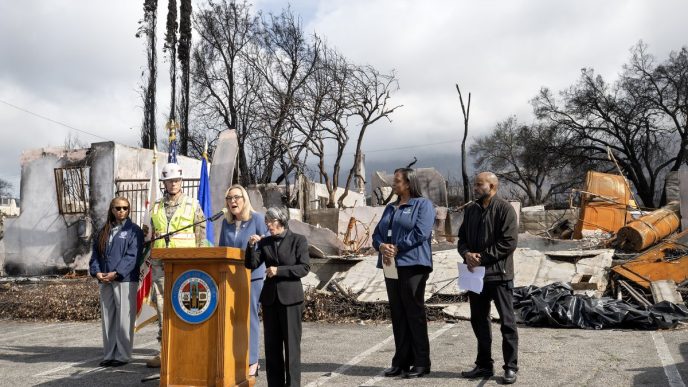The Los Angeles County Board of Supervisors on Tuesday allocated $637 million for homelessness services.
The board’s 5-0 vote followed several amendments for budget adjustments and a nearly four-hour public hearing.
Most of the funding is from the over $535.4 million from 2025-26 Measure A funds, a one-time Measure H carryover totaling more than $59.2 million and nearly $42.6 million from the state’s Homeless Housing, Assistance and Prevention Grant Program.
Supervisors were tasked with choosing one of six formulas for distributing more than $96 million from the county’s Local Solutions Fund.
The board considered adopting baseline and target metrics as recommended by the Executive Committee for Regional Homeless Alignment, a move opposed by a number of local officials and community members.
Palmdale Mayor Richard Loa urged the board to reconsider the allocation, saying the budget disproportionately takes away money from cities and unincorporated areas that need it the most.
A representative from LA City Councilwoman Nithya Raman’s office agreed with Loa, adding that the council’s Housing and Homelessness Committee and Mayor Karen Bass were also concerned about how funds would be distributed based on the new metrics.
The board chose Formula No. 4 after an amendment offered by Supervisor Janice Hahn, who said she supported equity in funding allocation to cities. The adopted funding formula bases cities’ shares on data from the annual point-in-time count required by the U.S. Department of Housing and Urban Development to assess homelessness and the American Community Survey, which “focuses on families with an annual income of less than $10,000, serving as a proxy for the deep poverty correlated with the doubled-up student homelessness not included in the PIT count,” according to a report by the county Chief Executive Office.
Carter Hewgley, senior manager of the LA County Chief Executive Office’s Homeless Initiative, said prior to the vote that Formula No. 6 stood out as a good way to incentivize positive results. The sixth and final option considered information from the Very Low-Income Regional Housing Needs Allocation in addition to PIT and ACS data.
Responding to a question from Hahn on barriers to clearing encampments and getting people into permanent housing, Cheri Todoroff, executive director of the county’s Homeless Initiative, said, “The biggest barrier — there’s only one — it is permanent housing. It is having access at a much higher scale to apartments that folks can move into. Ideally what we would want to see is having nobody stay in any interim housing site.”
According to Homeless Initiative data, 58 LA County residents in areas outside the city of Los Angeles transitioned from homelessness to permanent housing in 2024, while 662 moved into shelters or motels.
“This is why we have a homelessness crisis, we don’t have enough affordable housing,” Todoroff said.
Other concerns voiced by residents included the reduction of about $7 million for new efforts to reduce homelessness and services for unhoused youth. Several residents addressed the board and emphasized the need for supporting youth and immigrants who are currently or are at risk of experiencing homelessness.
Supervisor Lindsey Horvath said Formula No. 4 benefited a majority of the county’s 88 cities, but called for more funding for measures aimed at preventing youth homelessness. She suggested diverting some money to the Pathway Home Program, a collaborative effort involving the county and local jurisdictions.
Horvath submitted two amendments to the fourth formula to restore transitional youth expenditures, housing navigation and transitional housing for special population, among other items.
Supervisor Holly Mitchell disagreed with those suggestions, instead supporting preventive services, but did not want funds to be taken away from the Pathway Home Program. After deliberations, the board found a middle ground on adjusting the funding.
“Thanks to voters, our county’s 88 cities will finally have direct, reliable funding to address the unique homeless crises facing their communities with the solutions that work best for their residents,” Hahn said. “But just because this is new, doesn’t mean we should start small. I want to get our cities the most amount of funding possible so they can start strong, make a difference in unsheltered homelessness, and be real partners in this work with us.”
Horvath released the following statement following Tuesday’s vote:
“Our communities are tired of the status quo. They are frustrated with sharing their voices only for them to be ignored in the process. The days of rubber stamping are over. It’s time for outcome-based budgeting, where we invest in programs that house the most people with our limited dollars, and standardize care across our system,” Horvath said.
“We must ensure every dollar invested in homeless services is used wisely and leads to real results. Cutting funds for our transition-age youth is both cruel and irresponsible, and sacrificing our prevention services cuts our most cost-effective way to keep people housed and risks increasing flow into homelessness,” Horvath continued. “We need more transparency and to genuinely listen to those who are directly impacted.
“This budget underscores the urgent need to consolidate homelessness services into one department, allowing us to better track investments and outcomes, and standardize services to maximize every dollar spent,” she said.
A detailed report on the funding for addressing homelessness is on the county’s website.













